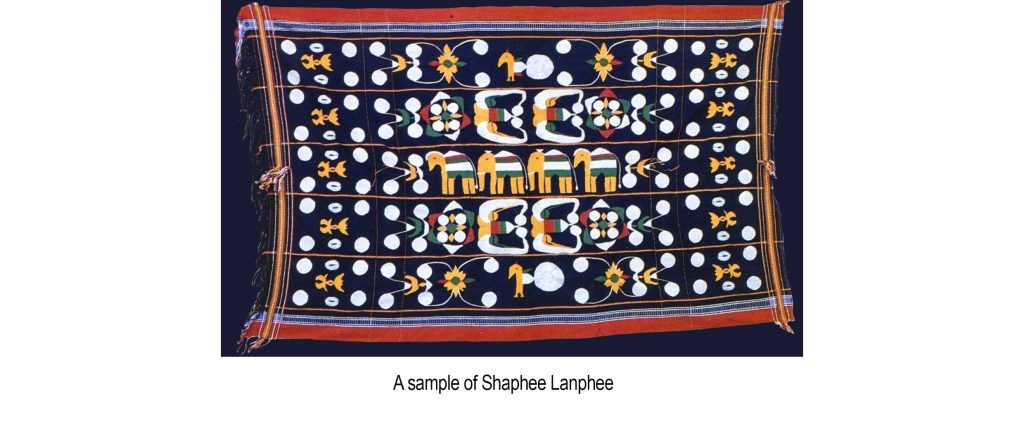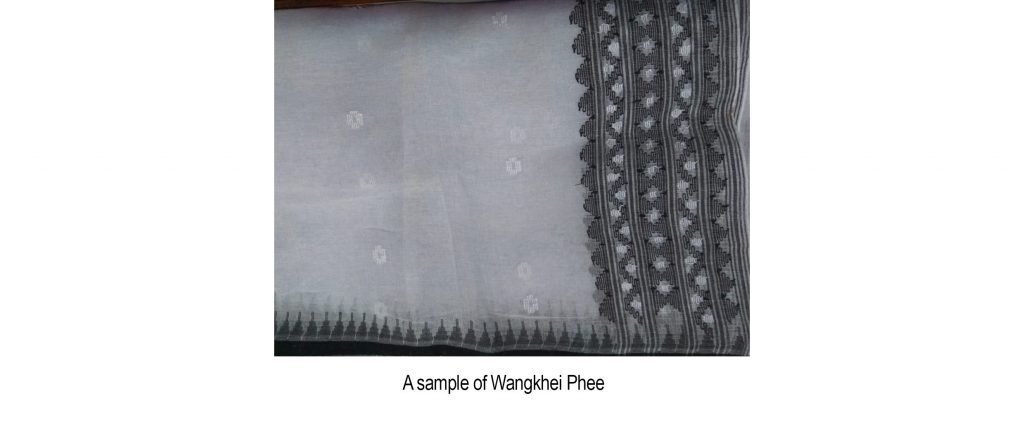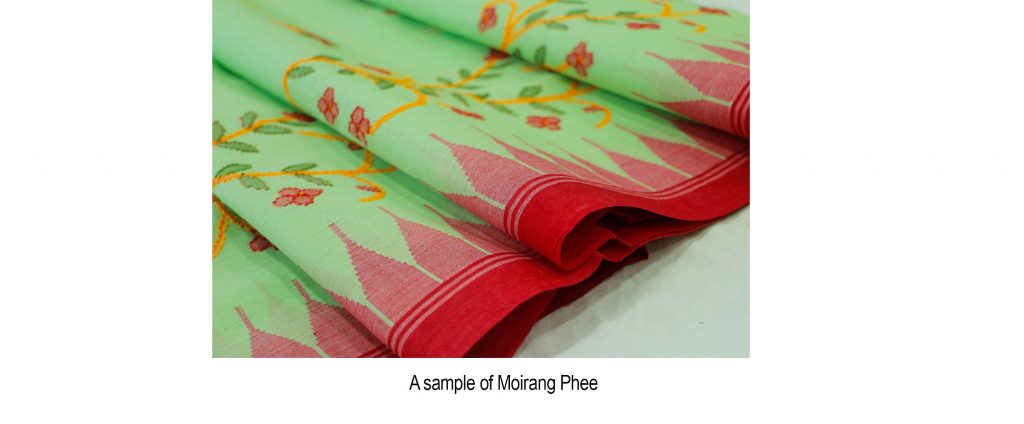GI Tagged Textile Fabrics of Manipur

A Geographical Indication or GI is a sign used on products that have a specific geographical origin and possess qualities or a reputation that are due to that origin. In India, GI Tags are issued by the Geographical Indication Registry under the Department of Industry Promotion and Internal Trade, Ministry of Commerce and Industry. Three handloom products of Manipur have got GI tag so far- Saphee Lanphee, Wangkhei Phee and Moirang Phee under Sub-section (1) of Section 13 of Geographical Indications of Goods (Registration and Protection) Act, 1999. Apart from these three products, an application for registration of Leirum Phee for Geographical Indication has also been made by the Department of Commerce and Industries, Government of Manipur.
Saphee Lanphee (GI application no. 371)

The Shaphee Lanphee is a traditional textile fabric, usually, a Shawl, which is specially made by needlework without a frame over the Loin Loom fabric woven by Meitei Women. It has its historical significance that it was used as Mana Phee (Reward) by the kings of Manipur as a token to honour their brave soldiers coming back home victorious after a battle. It marks pride and honour for the person who possesses it. The stylized motifs of the Shaphee Lanphee are now popularly used as waistcoats with synthetic lining.
‘Shaphee’ refers to the fabric of animals and ‘Lanphee’ refers to the fabric of war. It has a black background and a red border fabric decorated with 10 different stylized motifs: Shamu (elephant), Shagol (horse), Iroichi (buffalo horn), Nga (fish), Numit (sun), Tha (moon), Thawanmichak (star), Phantup (seat), Ta(spear) and Wahong (peacock).
The philosophical concept of the different motifs which are needed in the Shaphee Lanphee is that the floral design with the red core signifies the sun. The white patches at the ends signify the stars and the other heavenly bodies in the sky. The concept of the moon and the sun are the symbols of mother and father. The significances of this cloth of attractive motifs are the representation of the relationship between the celestial bodies and the Meitei King. The celestial bodies like the sun, moon, stars, etc. are the symbolization of the supreme power of mother and father. The motifs of Phantup (magical seat) and the elephant symbolize royalty. The motifs of spearheads and the fishes are connected with the myth of King Naothingkhong (663-763 A.D.). These different motifs of Shaphee Lanphee have made the craft a more popular and much-liked item in the international market.
Wangkhei Phee (GI application no. 372)

Wangkhei Phee is a textile fabric made of white cotton and is popularly worn by Manipuri ladies as a special clothing item for marriage ceremonies and other festive occasions. The fabric is transparent and has many designs on its body. The fine cotton fabric is known as “Wangkhei Phee” since the fabric was first developed in the Wangkhei area by skilled weavers for the Royal family. The fabric is extremely delicate prepared in fine cotton yarn. The interlacement of two threads, i.e. weft and warp in the series, are woven far apart from each other, and as such, the cloth is almost transparent. The Manipuri weavers had been weaving this kind of cloth by using the extra weft technique designs of Kheiroithek, Thangjing Tangkhai, Kabok Chaiba, and many others with Moirang Phee Designs on both of its longitudinal borders. Extra weft designs are woven in nature, like, floral, fruits, motifs, etc. It is one of the most luxurious items for ladies among the local clothes used on different occasions.
Moirang Phee (GI application no. 373)

The “Moirang- Phee” is a textile fabric that has a specific design called ‘Moirangpheejin’ which is woven sequentially on both longitudinal edges of the fabric and oriented towards the centre of the cloth with cotton or silk threads. Originally, it was first developed in the Moirang village of Bishnupur district. The name of this particular cloth also carries significant meaning and beliefs. It is believed that the Moirangphee was first made by the local people as a token of tribute to the then royal family of Manipur.
The “Moirang Pheejin” design which is woven in the Moirang Phee is derived from the pronged teeth of the “Pakhangba”, the Pythonic God of Manipur mythology. The name of this Moirang Phee fabric with Moirang Pheejin design along the border was also known as’ Yarongphi’ in the local name (ya = tooth and rong = long = longba = pronged). The teeth with upward pointed tops, when arranged in a regular and uniform series, have appealing touch on the aesthetic perception of the people. The design is woven in all the luxurious local cloths which are used on different occasions relating to marriage, festivals, public functions, rituals, etc. The design is one of the commonest designs woven in any of the handwoven fabrics of Manipur most popularly on ladies’ attires. The presence of Moirang Pheejin design in any one of the handwoven fabrics is significant as it shows that the fabric originated from Manipur.


